Martin Releases v2.80 for M1, M-PC & Maxxyz Desk AND Expands M1 to 16 Universes
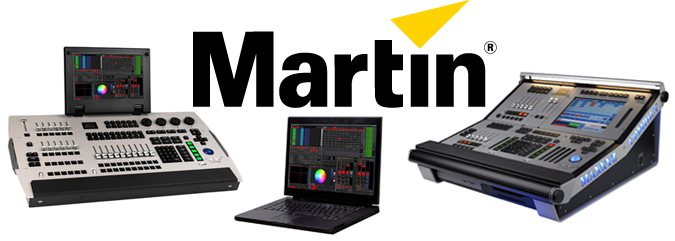
This is what I love about lighting desk as of late. You want a new feature or more capabilities, just wait for the next FREE software update! Since most desk these days are computer passed, getting new features on your desk of choice is as simple as running an update. Martin Professional is a prime example of that with the release of version 2.80 for the M1, M-PC and Maxxyz desk.
Here is more from Martin:
By adding a host of new features, including full RDM support and introducing a new DMX licensing system, version 2.8 software for Martin’s M1, M-PC and Maxxyz lighting consoles is a milestone release that further enhances the value of Martin’s professional controller line for its rapidly growing user base.
Over the past year, Martin has positioned its controller systems as a feature-packed, powerful, but affordable solution in the professional lighting market by offering attractive solutions without compromising the usability and quality of the hardware.
RDM Support
Martin continues its company-wide support of the RDM standard by adding a comprehensive RDM control system to its controllers. Users can now monitor RDM-enabled fixtures connected to a Martin console either directly inside the software or remotely from a website hosted inside the console. This features the ability to download status reports across the Internet, showing real world usability of RDM and adding real value for the customer. RDM is supported over the integrated DMX ports and over Artnet.
DMX Remote Input and Capture
It is now possible to receive up to 16 Universes of DMX input for remote control of cues, fixture levels or simply to manage HTP and LTP merging of an additional lighting desk into the system. 16 Universes can also be captured into the console programmer to read out cues from existing shows into the console. The comprehensive DMX Input feature set allows Martin’s controllers to stay at the heart of the DMX system while having full control over the merging behavior.
Quick-Peek
A new innovative feature is the ability to “peek” at any screen view. Holding down a screen-view button for more than two seconds automatically enters the Quick-Peek function. The view reverts to the original one once the button is released, allowing for quick glances at information on the desk while reducing unnecessary button presses.
Customizable Function Keys
Martin controllers are known for their elegant and uncluttered hardware surfaces. To enhance fast access to often used functionality, all consoles offer a variety of F-Keys which now have a newly designed management system for fast configuration by the operator. Functions include Group and Preset selects, console locking, semitransparent onscreen keyboard, and many more useful options right at a user’s fingertips.
Martin One-Key DMX Licensing
With Version 2.80, the Martin M1 console increases its DMX support from 12 to 16 Universes. Additional Universes to the 4 included in the standard package of the desk can be added by purchasing a license package, connecting Martin’s Ether2DMX8 devices or by connecting a Martin One-Key with an M-PC license. More Universes are simply added dynamically as soon as the additional license is seen by the M1 console. This allows Martin M1 programmers to bring their own Martin One-Key and unlock any M1 console immediately for their shows, independent of the DMX Universes activated in the console.
Version 2.80 also increases existing Maxxyz PC and M-PC systems to 64 Universes from 32, and includes balanced multi-threaded DMX processing for modern multi-core CPUs. Version 2.80 software is available at www.martin.com.
Martin Professional Announces M-PC Control Software
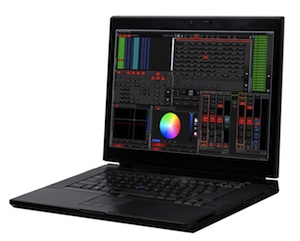 Following the successful launch of the M1 lighting controller, Martin Professional introduces two new PC-based controllers to its lineup.
Following the successful launch of the M1 lighting controller, Martin Professional introduces two new PC-based controllers to its lineup.
The M-PC Pro, which replaces the original Maxxyz PC, includes all the features of the Maxxyz PC plus all new features from the new M1 console. In addition, M-PC Pro has been upgraded from 32 to 64 DMX universes over standard Artnet or by using the Martin USB DUO DMX™, making it some of the most powerful PC-based lighting software ever made.
For budget-oriented applications, the M-PC Basic offers the same feature set as the M-PC Pro but can generate a maximum of 8 DMX universes. Both M-PC Pro and M-PC Basic come with the MSD5 (Martin ShowDesigner) MC Edition 3D Visualizer and one Martin USB DUO DMX.
In the same round of new releases, Martin also announces the addition of an M-PC 8 universes license to the Martin Ether2DMX8 Artnet to DMX converter. Once connected to a PC, the Ether2DMX8 will activate the M-PC Basic.
I personally am still waiting in the wings for Martin to realize that I am a Mac person and not a windows user. The M-PC is a windows only program…. at the moment hopefully. Learn more about the M-PC by visiting Martin’s website at www.martin.com.
Review: Martin M1 Lighting Desk
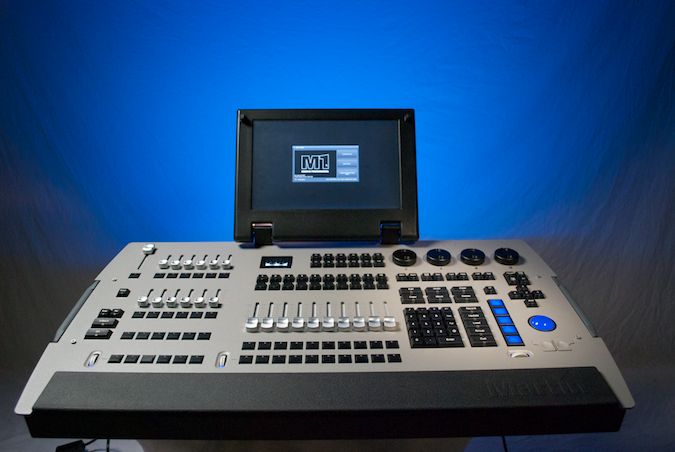
At ProLight + Sound this year, Martin Professional announced to the world their latest control product, the M1 Lighting Desk. Martin is boasting the M1 as the next generation of Lighting control in the lighting industry. With the form and function of the M1, it is pretty clear why they say that.
The M1 is a compact, portable and feature rich lighting desk compared to Martin’s other control desk options, the Maxxyz series of desks. There are numerous options and configurations available in the Maxxyz line up of desks, but nothing as affordable, lightweight and ready out of the box like the M1.
From the design and features built into the M1, I feel that Martin targeted the M1 to a specific portion of the market, the smaller touring market. At just under 32lbs., in a metal housing, the M1 is not only built tough, but looks tough. With it’s solid construction, the M1 should have no troubles handling anything a life on the road will throw at it.
[singlepic id=1101 w=320 h=240 float=left]On the surface of the M1, there is control coming at you where ever you look at the desk. The M1 has plenty of sliders, executors and paging wheels to make your head spin at first glance. Off to the far left, you have your theatrical style main playback. Just off to the right of the main playback are twelve single sliders with a function assignable button and twelve more single assignable buttons just below that. This is the first of two section of play backs. In the second section there are 10 playback faders, each with four function assignable functions right dead center of the desk for easy execution. No matter where your hands fall on the desk or what type of playback you might need, you’ll never be to far away from a playback.
If you did the math quick enough, that means that there are only thirty four places on the M1 to assign something for a playback. Don’t forget about the paging wheels. The ten center playbacks and the twenty four playbacks to the right have their own paging wheel to access even more playback underneath, up to 100 pages.
The M1 makes available 1000 cuelist which can be assigned to sliders with fade control or playbacks with control buttons. On top of those 1000 cuelist, you have the ability to add as many cues as you like with no restriction based on cue count. Just a bit of playback space no?
To help make the M1 even more lightweight and portable, Martin included a fold up 13” touch screen. No more worrying about if the monitors made it to the show, it’s built into the desk.
[singlepic id=1106 w=320 h=240 float=left]At the time of the review, the M1’s software was still in beta and wasn’t able to run a second monitor for more heads up display. Martin has already fixed this issue and updated the software to were the display port on the back of the M1 offers the ability to add a second monitor which also support ELO USD touch screens.
Under the hood of the M1 is an industrial motherboard with an dual core Intel Processor, integrated graphics all in a modular construction for easy repairs and replacement if something should ever go wrong. The M1 also features a 2.5” SATA hard drive at eighty gigs in size which is more then plenty to run the OS and save plenty of backups to your shows.
Speaking of Operating Systems, the M1 works off an industrial version of Windows XP embedded. Before the end of 2010, Martin is expecting to upgrade to Windows 7 embedded giving the M1 the power and performance of Windows 7. This will be a free software update from Martin. Now I tried my hardest, it was impossible to “break into” the Windows side of the desk, meaning Martin has locked down the core OS pretty well. Since the desk is based on Windows, saving and opening shows off of a USB jump drive is just as simple as on a PC.
[singlepic id=1105 w=320 h=240 float=left]Control on the M1 should never become an issue. Starting off with four universes of DMX right off the bat, smaller shows should have no problem controlling any small to medium sized moving rig. As time goes on, adding fixtures to any rig might cause a hiccup in control as those four universes of DMX quickly become filled. Not a problem with the M1. As your rig grows so can the M1’s universe count. While the M1 starts off with only 4 universes, you can add universes to the desk via universe licenses, up to 12 total via networking and Artnet.
For most of us, 6,144 parameters of DMX might be a bit much for our needs, but as time goes by and your rig keeps growing, you might out grow the M1. In the distant future when that time comes, you may have to upgrade to one of Martins Maxxyx line up of consoles. The best part is, you will not have to learn an new programing syntax! The M1 is the same programing syntax as Martin’s Maxxyz consoles. In fact, it is the same operating system! Now, if you are already a Maxxyz programmer, perfect, you already know the M1.
The M1 is based on the Maxxyz, layout and function of the desks are exactly alike. The M1 utilizes programmer and playback state of the console. The programmer side being where we enter the changes we like and then store them into some sort of playback whether that be a cue or submaster. The playback side of the desk is just as it sounds where these cue list, cues, effect, whatever you like to call them are, you guessed it played back.
Now if you feel that you need additional playback sliders at your finger tips and thirty four is just not enough, why not add a Max Module Playback, Button or Submaster Module? Since the M1 is based on the Maxxyz Console, the desk is easily expandable to your needs with addition sliders, executor buttons or submasters.
[singlepic id=292 w=320 h=240 float=left]You can even connect the M1 to a wireless access point and wirelessly connect an iPad, iPhone or iPod touch and run the free app from Martin, the MaxRemote. Just like any console remote like the MaxRemote, you have to have a little bit of network savviness to connect everything correctly. As a lighting professional in the digital age, this type of responsibility is required and demanded of us more and more.
After setting everything up correctly on the network, and on the iPad/iPhone/iPod Touch, using the MaxRemote to focus, program and run a show is fairly easy and straight forward after learning the Maxxyz syntax. The MaxRemote is a useful tool when connected to the M1 to fine tune focus points while on stage and away from the desk.
Overall, the M1 is a rugged, well designed and laid out touring desk. It has power behind it that can control almost any medium sized rig with no problem and has the ability to grow with your rig. I feel that the M1 was designed to be a busking desk and it shows with the amount of playbacks offered on the surface. It also offers the ability to playback as a traditional theatrical style desk making it very flexible. The M1 can be used in a wide variety of venues from traditional theatre, live performance, corporate events, the list can go on and on.
Don’t believe me, the M1 has already seen some action on some larger shows such as the World Cup. Not a bad start for a new console making it’s way to primetime in less then six months. I expect to see and hear about the M1 on many more shows and events of this size. You can follow the M1’s adventure on Facebook. You can also see the M1 up close and personal on the Martin Roadshow which is touring around the country this summer.
To learn more about the Martin M1 Lighting Desk, visit www.martin.com. Hve you had a chance to work on the Martin M1 Desk? What do you think? I would love to hear your comments about the desk and of course, this review.
[nggallery id=61]
Martin Introduces MAXRemote iPhone App
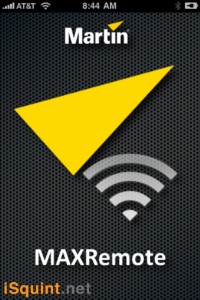 During LDI 2009, Martin announced that they released the MAXRemote iPhone App. The MAXRemote is an iPhone App to remotely connect to the Martin Maxxzy and Maxxyz PC lighting consoles.
During LDI 2009, Martin announced that they released the MAXRemote iPhone App. The MAXRemote is an iPhone App to remotely connect to the Martin Maxxzy and Maxxyz PC lighting consoles.
MAXRemote discovers remote lighting devices automatically and allows for manipulation of fixtures, presets, channels and more when users connect to a Maxxyz.
Multi-touch belts in the parameter view allow for manipulation of DMX values with great precision. A pan/tilt control even allows for control of a moving light’s pan and tilt via the iPhone or iPod touch’s built-in accelerometer.
Users can control color values in both CMY and RGB modes with support for Lee, Rosco and GAM filters. Users can also trigger cuelists with Go, Pause and Release commands. An offline mode allows anyone to experience MAXRemote without the need to have it connected to a Maxxyz system.
Features:
- Automatic discovery
- Controls Maxxyz remotely
- Black skin for dark environments
- Integrated help
- Passcode protected
- Saves show data for fast follow up synchronization
- Controls all fixtures in a show
- Integrated fixture search
- Create and edit presets
- Pan/Tilt view with built-in accelerometer support under sensor mode
- Color picker with support for Lee, Rosco and GAM filters
- Easy manipulation of all DMX channels
- Fast menu appears when shaking device (clears values quickly)
- Browse through fixture groups in a cover flow-like interface under landscape mode
- Start, pause and release cuelists, chases, etc.
- Exclusively for iPhone and iPod touch
The Martin MAXRemote requires a Maxxyz controller, but Martin has included a demo show file with the download to test out the MAXRemote to see how the app works. There was a some concerns brought up right after the release of the MAXRemote that parts of the app were a little to similar to Synthe FX Luminaire iPhone App. From what I understand, Martin and Synthe FX are talking and working out the issues.
MAXRemote is a free download from the iTunes App Store.
[nggallery id=18]
Martin Maxxyz PC Now with 2 FREE DMX Universes
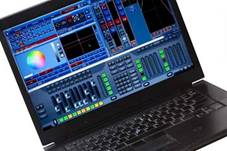 You have got to love free stuff! With the release Martin Professional’s latest software update to the Maxxyz PC lighting control, version 2.60. The crazy Danes from Martin has decided to throw in two universes of DMX with the Maxxyz PC controller.
You have got to love free stuff! With the release Martin Professional’s latest software update to the Maxxyz PC lighting control, version 2.60. The crazy Danes from Martin has decided to throw in two universes of DMX with the Maxxyz PC controller.
Simply connect the Martin Universal USB/DMX box to any Maxxyz PC to generate 1024 DMX channels. This is an ideal opportunity for Martin LightJockey™ users with larger requirements to experience all the power and benefits of Maxxyz PC.
You can download the latest version of the Maxxyz Control software from Martin’s website, www.martin.com.
Martin Introduces Maxxyz Module System
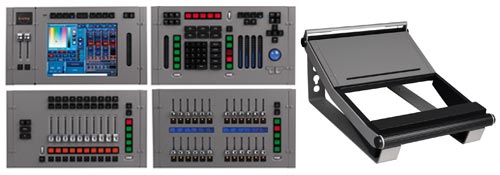
Martin Professional recently introduced a new line up to their line of Maxxyz Lighting control desk, the Maxxyz Module system.
Martin’s Maxxyz Modules is a lighting controller system based on a series of modules that can be used in different combinations to create a custom console to fit individual needs. Five modules are available to build a custom console or can be used with Maxxyz PC™, Maxxyz™ or Maxxyz Compact™.
All of them can be used table-top, mounted in a 19-inch rack system or in the Maxxyz™ Module Frame. Users can add additional modules as wings, swap modules within the frame or upgrade to a larger frame to build a new Maxxyz controller.
The module base includes a 2 DMX universe port so that whenever a module is added to a system two physical DMX connections are also added. Each module comes equipped with a built-in Maxxyz PC dongle. With its built-in 2 port DMX, each module is a small Maxxyz console with support for up to 32 DMX universes.
The Cerebrum module is a touch-screen computer and the core of the Maxxyz modular concept. It runs the lighting software on Windows XP Embedded which controls the Maxxyz Compact. The Cerebrum can also be used as a stand-alone unit for control in installations and also functions as a backup system for any Maxxyz console, Maxxyz PC or other Cerebrum module. Combined with the Maxxyz Manager software, it can be used to automate a complex lighting system.
The Programmer module is the main control unit of a Maxxyz system. This module can be used with the Cerebrum or with the Maxxyz PC software.
The Button Module offers up to 30 customizable direct access buttons. Each row of 10 buttons is individually assignable to cuelists, groups, fixtures or presets by the simple press of a Mode button. Furthermore, a set of 5 LCD buttons, 2 Up/Down keys and a scroll wheel provide direct access to functionalities related to each row of buttons. An encoder belt gives flexible access to such features as time, speed and future options. The Button module also works with the new Maxedia 4™ software to recall cues and other functions.
The Submaster module provides an additional 24 handles of controls for cuelists, channels, submasters or inhibitives.
The Playback module adds 10 motorized faders with 15 LCD buttons and a master Go section, extending the playback capabilities of Maxxyz.
The Frame module can accept up to two modules of any kind (except the Cerebrum which only fits in the upper position), making it possible to combine different modules in the same frame — thereby customizing it for a specific application. The included blind plate can be used to hold a laptop or notes and paperwork.
For more information, please visit www.martin.com.
From PLSN
LatestHeadlines
- Upgrading Your Toolbox: City Theatrical DMXcat-E and DMXcat Multi Function Test Tool
- Claypaky Bringing Back the Sexy to Par Cans with the Midi-B FX
- Ayrton Evolves the Cobra, the Cobra2 Developed for the US Market
- MA Lighting Intros grandMA3 onPC Fader Wing and DIN-Rail Nodes
- Live Events LEVL Up Fest: A Festival to Aid our Industry